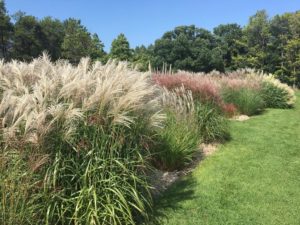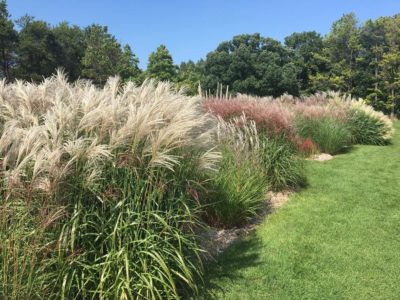September 2021
by Matthew Olson
As I write this blog, the weather outside is hot, sunny, and humid. Summer is obviously still here. But I’m starting to see hints of Fall approaching. The daylight is becoming shorter, and the sound of the evening crickets is growing louder. For many of us, the flowers on our summer perennials are starting to fade. The summer annuals are still growing strong, but soon they will begin to slow down as well. In today’s blog, we’ll look at some perennials and annuals that can provide us with late season color deep into the Autumn season.
The first perennial we’ll look at is one of my all-time favorites, Rudbeckia ‘Goldsturm’. This commonly grown perennial features bright yellow flowers that are shaped like daisies. Rudbeckias typically begin blooming in late July and continue through September. ‘Goldsturm’ is a classic variety that was developed in 1937 and has been popular ever since. In the last few years, several new varieties of Rudbeckia have emerged into the market. These newer varieties are an improvement of ‘Goldsturm’, a variety that is prone to a fungal disease called Septoria leaf spot. The variety ‘American Gold Rush’ is similar to ‘Goldsturm’ but is resistant to the leaf spot. Some of the newer varieties, such as ‘Toto gold’ are more compact as well.
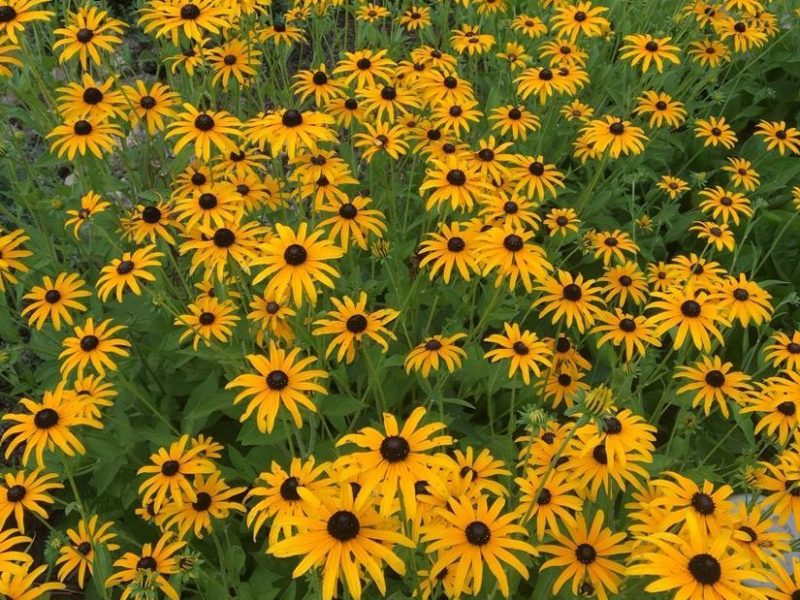
There are many perennial groundcovers that gardeners can grow, and most of them feature beautiful flowers that typically bloom in late spring and early summer. However, there is one groundcover that puts on a spectacular floral display from August until the first freeze. The Japanese Anemone, which is Anita’s favorite, is native to China and features bright pink or white flowers that bloom for nearly two months in the fall. Similar to many groundcovers, this plant grows best in part shade in soil that stays moist but not wet. This plant is ideal for woodland gardens and perennial borders where it has space to naturalize. One thing to note is there’s also a perennial called Snowdrop Anemone, which blooms in spring and is different than Japanese Anemone.
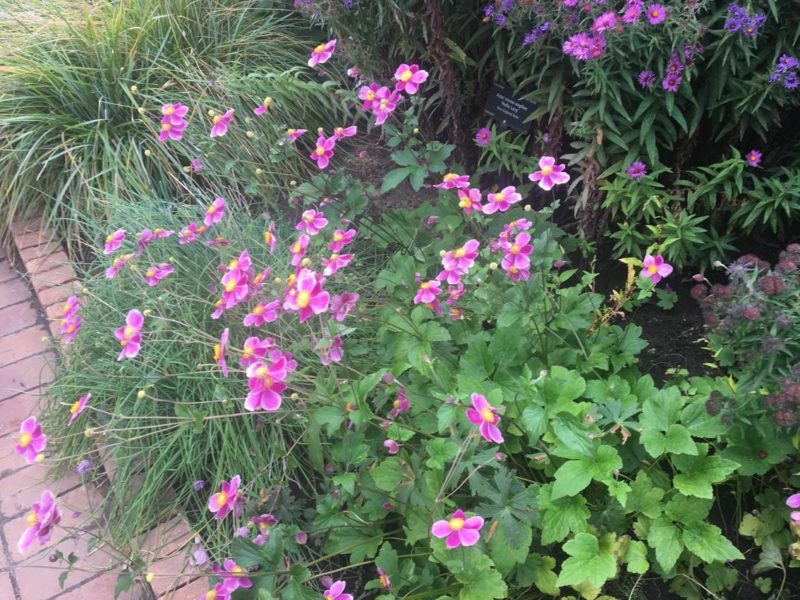
One group of plants that I’ve begun to appreciate the last few years are ornamental grasses. These perennials can seem ordinary during the summer, but as Fall draws near, they begin to rapidly change. Ornamental grasses can range from 2-10 ft tall, depending on the variety. My favorite grass is Miscanthus Sinensis ‘Purpurascens’ (Flame Grass), which features silver plumes and foliage that turns orange in Fall. Another favorite of mine is Panicum virgatum (Switch Grass), which feature airy plumes and foliage that turn red at the tips of the leaves. There are a few ornamental grasses that are considered invasive, so it’s best to shop at a reputable nursery to ensure you’re buying non invasive grasses. One more benefit of ornamental grasses is they provide structure in the garden during winter if you choose to leave them up for winter interest. If you’re interested in seeing ornamental grasses in the landscape, I recommend going to the Minnesota Landscape Arboretum to see their extensive collection of Grasses.
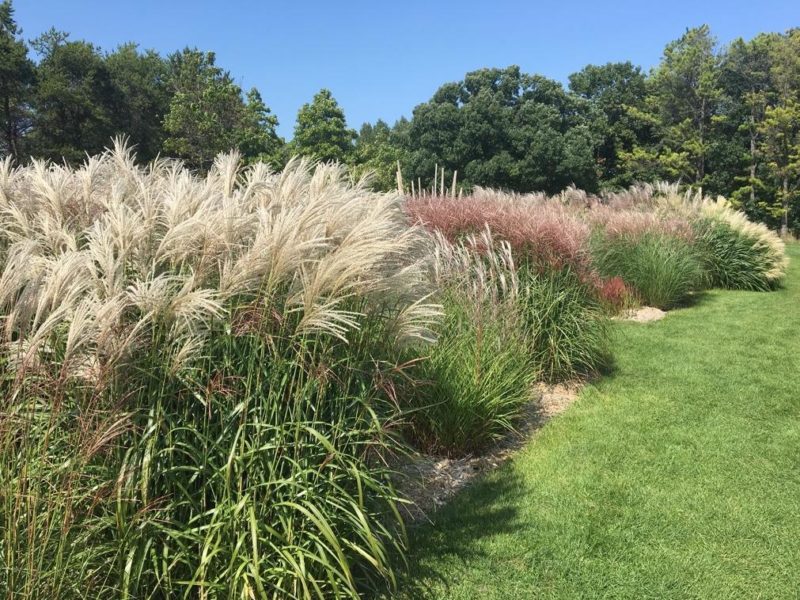
If you’re in search of a late blooming vine, look no further than the Sweet Autumn Clematis. Unlike most clematis, this vine begins blooming in late summer and goes into early fall. The flowers of this Clematis are white, small and cover the whole vine. They are fragrant as well. This type of Clematis may self seed, which is something to keep in mind if you plan to grow it.
Hiking is one of my favorite activities in Fall, and one plant I frequently see are Asters. These native plants save the best show for last. They are a great source of nectar for pollinators in the final days of warm weather, and they frequently bloom until the first hard freeze. Some Asters begin blooming in August, and others don’t bloom until October. Asters can range from 6 inches-8 ft tall depending on the variety.
One of the easiest perennials to grow is Sedum. The Sedum that blooms in Fall is the upright sedum that grows to 18 inches tall. Like the Aster, it’s a pollinator magnet. The commonly grown Sedum are in the Autumn series, which features several varieties of the same Species. For best performance, they should be grown in full sun areas with well-draining soil.
One of the more unique perennials that bloom in Fall is the Turtlehead. There are two species of Turtlehead typically found in Minnesota, one is native to the southern U.S, and the other is native to Minnesota. The species that is native to the south is more commonly grown in Minnesota gardens. Chelone lyonii ‘Hot Lips’ features bright pink flowers that are shaped like Turtleheads. This perennial forms large clumps that attain a height of 2-4 ft. They have dark green foliage that stays healthy looking throughout the summer. This plant grows well in part shade areas that have moist soil. The native species of Turtlehead features white flowers and is not as compact, making it less popular for gardens, but you can find it along the edges of lakes in wetlands.
Creating annual displays in Fall is a great way to keep your garden looking fresh, while creating a festive accent for the Fall season. The most popular Fall annual is the Chrysanthemum. Mums are an effective way to add a pop of color to your containers or beds, they also come in many colors. They usually bloom for about a month before the blooms fade. For optimal bloom time, it’s best to buy mums that are just beginning to bloom.
Celosia is a common annual for summer, but it’s also used in Fall displays. The bright yellow, orange and red blooms are striking colors that remind us of the leaves changing color. One of the benefits of Fall displays is their ability to look good well into November if the temperatures stay above 20 degrees.
Ornamental vegetables such as Kale and Cabbage can withstand a hard freeze and still look good. In fact, the color on their leaves will intensify with colder weather. Sweet Alyssum is another annual that will bloom right into November unless it’s buried in snow. You can even use perennials for Fall container displays, such as Rudbeckia and Creeping Sedum. Dusty miller offers striking foliage that is white. Purple fountain grass is an annual that features red/purple foliage with brown plumes that make it perfect for Autumn. In addition to plants, Gardeners will often add pumpkins other autumn themed items to complete the display.
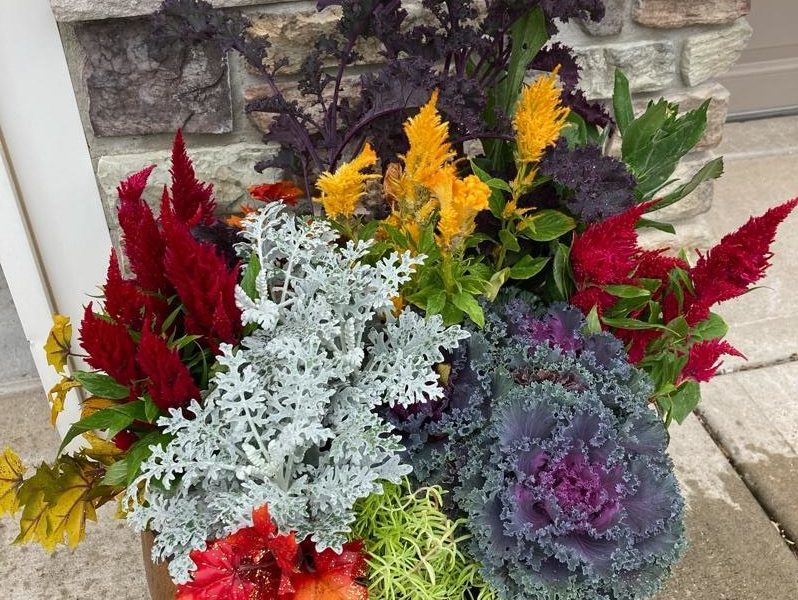
Having plants that bloom in Fall is a perfect way to ease the transition from summer into winter. These plants give us something to look forward to in the garden at a time of year when many plants in nature begin to slow down. I hope you’ll consider having a Fall display of your own. Happy Gardening!

